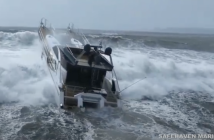NOAA just named a Long Island Sound estuary as a protected place, establishing a 52,160-acre National Estuarine Research Reserve. The area includes part of Long Island Sound, part of Fisher’s Island Sound, and portions of the Thames River and the Connecticut River. See NOAA’s announcement, dated January 14, here:
Today, NOAA and the State of Connecticut designated a new national estuarine research reserve in Long Island Sound. Research reserves are designated to protect a section of an estuary and provide a living laboratory to explore and understand important areas where rivers meet the sea, thus promoting understanding and informed management of coastal habitats.
The Connecticut National Estuarine Research Reserve spans 52,160 acres in the southeastern part of the Constitution State. It is the 30th reserve in the national estuarine research reserve system, and the first in the state.
This new research reserve is consistent with the Biden-Harris Administration’s America the Beautiful initiative, which commits to conserving at least 30% of U.S. lands and waters by the year 2030, including by expanding the national estuarine research system.
“NOAA is doing all we can to advance the President’s conservation goals to help address nature loss, mitigate climate change, and create equitable access to the outdoors,” said NOAA Administrator Rick Spinrad, Ph.D. “Protecting special places along our coast and making them accessible for future generations benefits our planet, our people, and our economy, and helps build a climate ready nation.”
The Connecticut National Estuarine Research Reserve will be managed as a partnership between NOAA and the State of Connecticut. The research reserve will facilitate new partnerships and collaborative research to improve coastal management, local community sustainability, and ecosystem resilience.
“The designation of the nation’s 30th National Estuarine Research Reserve in Connecticut represents a win for science-based decision making and helping to enhance environmental education at all levels for the people of Connecticut,” Governor Ned Lamont said. “We’re excited that some of the amazing natural resources of Long Island Sound, the Connecticut River, and some of our state parks and natural area preserves will be utilized as a living laboratory that can help advance national efforts in addressing issues such as climate change and environmental stewardship now and in the future.”
“Partnerships are key to the success of our research reserves, and support from the Connecticut congressional delegation, state officials, and local leaders was critical to this designation,” said Nicole LeBoeuf, director of NOAA’s National Ocean Service. “Each reserve brings together stakeholders, scientists, land management professionals, and educators to understand coastal management issues and generate local, integrated solutions, while leveraging the science generated within the nationwide network of reserves to make our coasts more resilient.”
Within the boundaries of a research reserve, communities and scientists work together to address natural resource management issues on a local scale. These issues include nonpoint source pollution, habitat restoration, and invasive species. Reserves also help make the nation climate ready by contributing to efforts to make the U.S. coasts more resilient to natural and human-made changes. Read more:
https://www.noaa.gov/news-release/noaa-names-long-island-sound-estuary-as-protected-place




